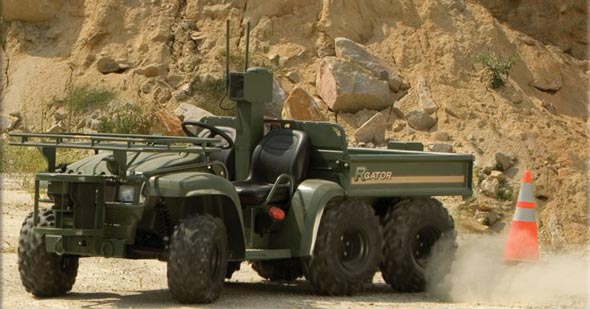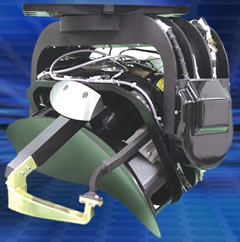Recent years have seen a substantial change in US power projection capability. For decades this capability was based on the use of aircraft carriers; now the US possesses the unique capability of executing an extensive, intercontinental attack without the need to operate from foreign territory. An American attack on Iran, if executed, could possibly be the first significant demonstration of this capability. The next stage will be the ability to carry out such an operation within a shorter response time than is currently possible. With bilateral rhetoric escalating and war drums beating – anything can happen next.
Five years ago, “Operation Iraqi Freedom” could be launched only after the United States established an international coalition and massing troops and equipment, giving clear signs to the enemy over what he could expect. A similar build-up preparatory act became necessary in 1991 to start “Operation Desert Storm”. Few years later, in order to strike at Iran’s nuclear infrastructure, large scale preparations forewarning may not be provided prior to a devastating “Shock and Awe” massive air strike.
Transforming Force Projection
Since the Second World War, US global power projection strategy centered around the Navy’s aircraft carriers and their air wings. The ability of an aircraft carrier, together with its escort ships to deploy in relatively short time into a crisis region and be ready for immediate action upon arriving, has granted it a large degree of operational flexibility. However, aircraft carrier could be too slow and restricted to respond anywhere in the ‘global village’, where much faster ‘Global Strike’ capability could be employed. Sometime, the mere fact that an aircraft carrier group is deployed to a region may be enough to ease an escalating tension. Other events could benefit from the added world attention and could be better handles by a surprise attack. Carrier Air Groups (CAG) are also limited by range, flight routes and operational capability. While a CAG is well equipped to conduct all types of missions within its area of responsibility, it still lacks the stealth capability considered essential for strategic attacks. Joint planning and operation between the US Navy and Air Force, particularly in the earlier phases of a campaign is required, when enemy air defenses are in their full capacity. At these phases only a small part of the force is available to attack the mission’s main targets.
Introducing ‘Global Strike’
With the introduction of Global Strike capability under US Strategic Command (STRATACOM), the United States has full capacity to wage war across the globe originating from the continental United States. This includes an ability to strike at up to 10,000 aim points almost simultaneously in conventional attack.
For several years, STRATACOM explored it’s global strike plan through a series of exercises entitled “Global Lightening”, simulating an attack using both conventional and nuclear weapons against a ‘red force’; the timing of the exercises, clearly suggested that they were conducted in anticipation of a planned attack on Iran.
The operational implementation of the Global Strike is defined in the Concept Plan, which outlines the joint operation for the Navy and the Air Force, which further translate it into combined strike plans for surface vessels, submarines, fighters, bombers and support operations. But unlike the 1981 Israeli air attack on the Iraqi nuclear center ‘Osirak’, an attack on Iran’s nuclear facilities would prove more complex because Iran dispersed its strategic nuclear facilities across the country, in underground shelters well guarded with sophisticated air defense systems.
Pentagon planners are studying how to penetrate such deeply buried targets and are contemplating tactical nuclear devices. For example, the Natanz facility consists of more than two dozen buildings, including two huge underground halls built with six-foot walls and supposedly protected by two concrete roofs with sand and rocks in between.
Hit with Shock and Awe
Potentially, stealth bombers operated by the U.S. Air Force and long range missiles launched from Navy vessels and submarines and standoff missiles launched from Naval F/A-18s and Air Force F-15Es could hit thousands of individual targets in Iran in a few hours (utilizing independently targeted, stand-off strike weapons such as JDAM, and SDB from bomber platforms). “We’re now at the point where we are essentially on alert,” Lieutenant General Bruce Carlson, former commander of the 8th Air Force, the heart of Strategic Command (STRATCOM), stated. “We have the capacity to plan and execute global strikes in half a day or less.”
Since October 2007 under command of former NASA Astronaut General Kevin P Chilton, US Global Strike planning has the potential to destroy thousands of targets in Iran in one mission with “smart” conventional weapons. That number assumes only 100 strategic bombers with 100 bombs in strike packages are directly involved. The Pentagon assures that the US has strategic forces prepared to launch massive strikes on Iran within hours of the order being given.
According to professional assessments, such strike power alone seems sufficient to destroy all major Iranian political, military, economic and transport capabilities but could it defeat Iran’s well protected and widely dispersed nuclear facilities and ballistic missiles?
US military experts keep coming back, warning that it will require a nuclear penetrating munitions to take out those facilities” said Kenneth M. Pollack, a former CIA analyst. “Could we do it with conventional munitions? Possibly. But it’s going to be very difficult to do.” Some of the answers are already available. New types of bombs that the US B-2A carries include a new earth penetrating conventional weapon, the Massive Ordnance penetrator. The MOP is a 30,000lb bomb carrying 6.000lbs of explosives and capable of penetrating up to 60 meters [200 feet] through 5,000 psi reinforced concrete. This should put at risk even the most hardened subterranean facilities, such as Natanz, increasing the flexibility of STRATCOM’s conventional strike options. In recent years, hugely increased funding for military technology has taken “smart bombs” to a new level. “Bunker-buster” conventional weapons are also coming in smaller dimensions. Nowdays bombs weighing only 250lb already have the capability to destroy well protected targets.
Such an attack will definitely rise the “shock and awe” strategy to a new level, leaving Iran with few, if any conventional military capabilities to block the straights of Hormuz or provide conventional military support to insurgents in Iraq- which are their main threats. A successful strike, based on accurate precision intelligence, could also curb any second strikes by Iranian ballistic missiles, following a first launch effort, which may not be prevented. Shock and Awe proponents could argue that such first nock-out Iran will be crippled and devastating, with no willpower to continue fighting. But if this isn’t the case, could the US continue beyond the first round?
If the outcome of the first round is not sufficiently clear, airpower could continue to pound targets with smart weapons, particularly the Small Diameter Bomb (SDB), which has quadrupled the US Air Force attack capability, enabling F-15Es and B-2As to carry twice and even four times more weapons per sortie. A single stealth B-2 or legacy B-52 or B-1B bombers can now attack between 150 and 300 individual points within a meter of accuracy using the global positioning system. Indeed, US military preparations and current operations against Iran indicate a full-spectrum approach to Iran rather than one confined to WMD sites alone.
An additional important component of US new power projection capability is the Tomahawk cruise missile. The missile was first employed in 1991 and since then hundreds have been launched in operational actions. But in this area too fundamental changes have occurred in recent years. In 2004 a new version of the missile came into service; its greatest advantage stems from its two-way communication ability. The operational significance of this is that the missile transmits via satellite communication an image of the target seconds before it is hit. This capability, absent from previous models of the missile, enables an assessment of the results of an attack in real time.
Operating within the Coalition
A situation in which Iran is attacked by B-2A bombers as well as cruise missiles coming in from all directions will make it difficult for its air defenses to function successfully. Unlike bombers having to cross the airspace of several countries, the cruise missiles can be launched without any need to coordinate with other countries. The combination of B-2A bombers and cruise missiles would enable the simultaneous strikes on hundred of targets in Iran as part of a broad move against its nuclear infrastructure. The combination of stealth and the bomber’s long range capability offer additional advantages. The fact that the US controls airspace over Iraq and Afghanistan enables the planning of penetration and egress routes regardless of international airspace boundaries, guaranteeing that not all bombers will come from the direction of the Persian Gulf, (i.e., southwest to northeast) as the Iranians can expect. Some of the attacking forces could use ingress routes from the east, over Turkey or the Caspian Sea while come from Iraq in the west, or even from Afghanistan in the East – the airspace of both countries is currently dominated by U.S. control. This means that Iran could find itself attacked simultaneously from several directions, and from points where its air defense system is thinner. Fighter planes with far shorter ranges would find themselves hard-pressed to execute such outflanking maneuvers.
In fact, the scenario depicted here should certainly not claim that a possible attack on Iran’s nuclear facilities via Global Strike would be simple or assured of success. The required intelligence to define and accurately pin point hundreds of designated targets become highly critical, without which an effective strike will become abortive.
Summary:
Assessing Iranian retaliatory actions, ballistic missiles and other threats should be taken seriously. It must also be assumed that in spite of its awe inspiring power projection, Global Strike strategy does not pretend to be a magical solution or a substitute for a determined diplomatic approach. But one matter is crystal clear; this type of capability is not at the disposal of any other country.

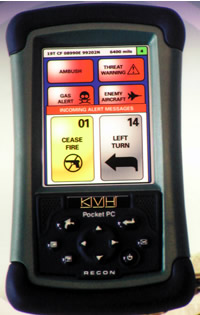
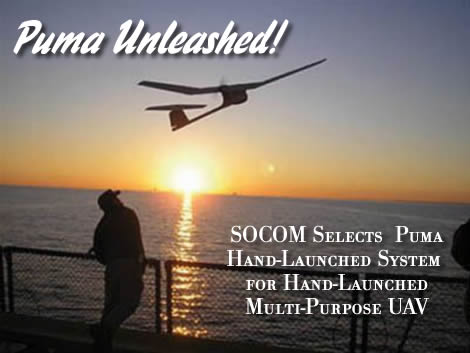
 Puma AE is the third generation of the AeroVironment Puma mini UAV designed to land near-vertically on both land and water. It is equipped with a day- and night-capable, waterproof sensor package that provides image tracking, image stabilization and high-image quality. The system incorporates the same hand-held Ground Control Unit used by U.S. Department of Defense and allied military customers to control the
Puma AE is the third generation of the AeroVironment Puma mini UAV designed to land near-vertically on both land and water. It is equipped with a day- and night-capable, waterproof sensor package that provides image tracking, image stabilization and high-image quality. The system incorporates the same hand-held Ground Control Unit used by U.S. Department of Defense and allied military customers to control the 
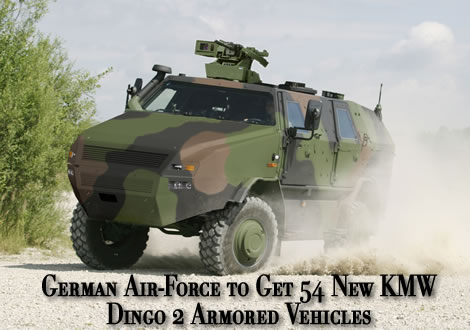
 Like all other new Armored Command and Control Vehicles (German: Geschützte Führungs- und Funktionsfahrzeuge =GFF) of the German Armed Forces under the GFF procurement program for self protection, the DINGO 2 is equipped with light and heavy weapon stations. The armored transport vehicle BOXER is also equipped with similar weapon stations for self-defense. The FLW systems can be remotely controlled and operated by the crew from inside the vehicle, under armor protection. The weapon stations carry optronic systems providing the operators with visibility and aiming by means of video monitoring, under daylight and night time conditions. The weapon mount is gyro-stabilized, improving aiming and firing stability while on the move. The ballistic computer is automatically set to identify and function with the type of weapon mounted – machine gun or automatic grenade launcher.
Like all other new Armored Command and Control Vehicles (German: Geschützte Führungs- und Funktionsfahrzeuge =GFF) of the German Armed Forces under the GFF procurement program for self protection, the DINGO 2 is equipped with light and heavy weapon stations. The armored transport vehicle BOXER is also equipped with similar weapon stations for self-defense. The FLW systems can be remotely controlled and operated by the crew from inside the vehicle, under armor protection. The weapon stations carry optronic systems providing the operators with visibility and aiming by means of video monitoring, under daylight and night time conditions. The weapon mount is gyro-stabilized, improving aiming and firing stability while on the move. The ballistic computer is automatically set to identify and function with the type of weapon mounted – machine gun or automatic grenade launcher.